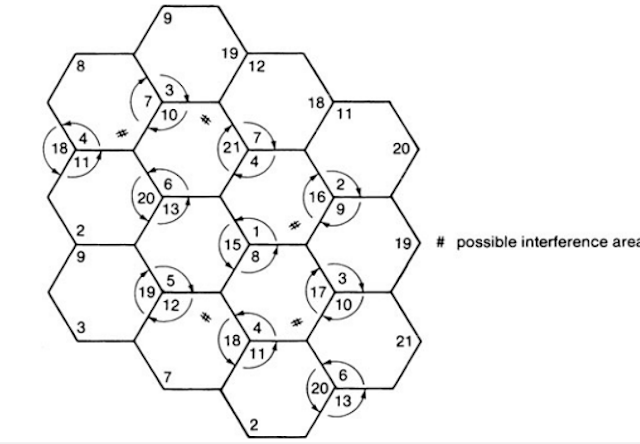Write about fixed channel assignment schemes in detail.
7. Write about fixed channel assignment schemes in detail.
Fixed Channel Assignment Schemes:
Adjacent-Channel Assignment:
Adjacent-channel assignment includes neighbouring-channel assignment and next-channel assignment. The near-end–far-end (ratio) interference, can occur among the neighbouring channels (four channels on each side of the desired channel). Therefore, within a cell we have to be sure to assign neighbouring channels in an omni directional-cell system and in a directional antenna-cell system properly. In an omni directional-cell system, if one channel is assigned to the middle cell of seven cells, next channels cannot be assigned in the same cell. Also, no next channel (preferably including neighbouring channels) should be assigned in the six neighbouring sites in the same cell system area (Fig. 7.1a). In a directional-antenna-cell system, if one channel is assigned to a face, next channels cannot be assigned to the same face or to the other two faces in the same cell. Also, next channels cannot be assigned to the other two faces at the same cell site (Fig. 7.1b). Sometimes the next channels are assigned in the next sector of the same cell in order to increase capacity. Then performance can still be in the tolerance range if the design is proper.
%20Omni%20direction%20antenna%20cells;%20(b).PNG) |
| Adjacent channel assignment (a) Omni direction antenna cells; (b) Directional antenna cells |
Channel Sharing:
Channel sharing is a short-term traffic-relief scheme. A scheme used for a seven-cell three-fac system is shown in Fig. 7.2. There are 21 channel sets, with each set consisting of about 16 channels. Figure7.2 shows the channel set numbers. When a cell needs more channels, the channels of another face at the same cell site can be shared to handle the short-term overload. To obey the adjacent-channel assignment algorithm, the sharing is always cyclic. Sharing always increases the trunking efficiency of channels. Since we cannot allow adjacent channels to share with the nominal channels in the same cell, channel sets 4 and 5 cannot both be shared with channel sets 12 and 18, a indicated by the grid mark. Many grid marks are indicated in Fig.7.2 for the same reason. However, the upper subset of set 4 can be shared with the lower subset of set 5 with no interference. In channel-sharing systems, the channel combiner should be flexible in order to combine up to 32 channels in one face in real time. An alternative method is to install a standby antenna.
 |
| Channel sharing algorithm |
Channel Borrowing:
Channel borrowing is usually handled on a long-term basis. The extent of borrowing more available channels from other cells depends on the traffic density in the area. Channel borrowing can be implemented from one cell-site face to another face at the same cell site. In addition, the central cell site can borrow channels from neighboring cells. The channel-borrowing scheme is used primarily for slowly-growing systems. It is often helpful in delaying cell splitting in peak traffic areas. Since cell splitting is costly, it should be implemented only as a last resort.

